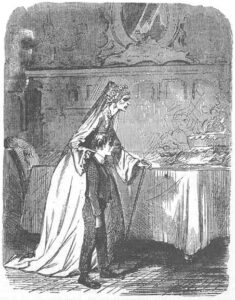“It was not in the first few moments that I saw all these things, though I saw more of them in the first moments than might be supposed. But, I saw that everything within my view which ought to be white, had been white long ago, and had lost its lustre, and was faded and yellow. I saw that the bride within the bridal dress had withered like the dress, and like the flowers, and had no brightness left but the brightness of her sunken eyes.” (Dickens 56)
This passage from Great Expectations describes the first time Pip encounters Miss Havisham, a rich elderly woman who invites him over to ‘play’. At first, Pip sees nothing but white in her room, as it is filled with all of the items that would be needed for a wedding. Then, in this passage, he realizes that all of the items are old and rotting, much like Miss Havisham herself, and this is where some interesting implications of the description can be drawn out. The fact that Pip did not notice the state of everything in the room ‘in the first few moments’ may speak to the sheer volume of items in the room, or the degree to which everything in the room was organized, as if for a wedding in the near future (Dickens 56). Then he realizes that all of it is old, including the would-be bride. This serves to introduce both Pip and the reader to Miss Havisham, a lady who was left at the altar and has been waiting for decades for her fiancé to come back, and has refused to move forward with her life. Her life paused at this point, and so did her room, but time still has affected her, despite her refusal to acknowledge its passage.
Miss Havisham’s position in her room and surrounded by the preparations for her wedding, as if she is still anticipating it, put her in an interesting liminal position in several ways. Firstly, she is forever stuck between a state of married and single, two positions which in Victorian times both held distinct roles and characteristics. By being forever stuck between the two, Miss Havisham has removed herself from the expectations of both positions, and placed herself outside of the social norms of marriage. She is not expected to look for a husband, as she would be if she were single, and she also does not have to do housework, as a consequence of her class but also the fact that she does not have a husband or family to care for. Secondly, the description of her as “withered” and her eyes as “sunken” serve to characterize her as a deathly figure, or someone who is stuck between the states of life and death, similar to a vampire or zombie. This is also an example of another way in which Miss Havisham occupies a liminal space in her life. Her occupation of this liminal space speaks to the fascination of Victorian readers and writers with the ideas of the Gothic, and its obsession with death, life after death, and life intertwined with death. Similar ideas can be found in Whuthering Heights, with Catherine’s promise to haunt Heathcliff as a ghost, and Heathcliff’s climbing into Catherine’s coffin.

https://victorianweb.org/art/illustration/mclenan/13.html
I loved reading your post. I would like to add that in recalling the elements of the gothic, the scene you pointed out is a perfect example of how gothic Victorian literature often experimented with place and time. The entire room Miss Havisham resides in is a moment frozen in time. As you explained, not only is Miss Havisham in a liminal position, but she is in a liminal space that seemingly transports Pip to the past once he enters it. Even her clocks are frozen on a specific time. However, Miss Havisham and her surroundings are still a victim to the passage of time, unable to escape the effects of age. So while at first glance, the room is a snap shot of a specific event, upon closer inspection, the scene is one of decay, and the event has evidently long passed. Miss Havisham is unable to let go of the past but also unable to fully escape the present.
Your take on liminal spaces within Miss Havisham’s character was really interesting. Her midway social position as the bride left at the altar leaves her feeling unfulfilled and confused because, as you mentioned, in Victorian society women’s roles were defined as either being single or married. Since Miss Havisham fits into neither, she experiences a liminal identity that causes her to descend mentally, potentially due to confusion with her identity. How do you think the confusion and liminality of Miss Havisham’s identity are projected onto Estella in how she raises her to interact with men, specifically Pip? How do you think she tries to have Estella define her own identity?